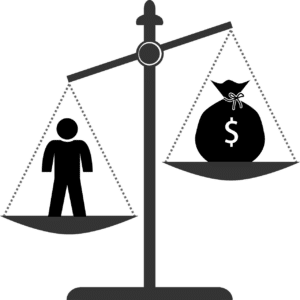by Jason Ruchaber, CFA, ASA
Price and value are two interconnected yet distinct concepts when it comes to evaluating transactions in physician practices. While price refers to the amount paid in a transaction, value represents a measure of the perceived worth of the item being exchanged. Warren Buffet succinctly captured this relationship when he stated, “Price is what you pay, value is what you get.”
Price is a tangible, objective measure often expressed in monetary terms. It provides a clear indication of the financial commitment required to consummate a transaction. On the other hand, value is a subjective concept that can vary among individuals and circumstances. In essence, value is derived from the utility or usefulness of the item in satisfying a particular want or need.
In a free and open market, the forces of supply and demand initially determine prices based on the overall perception of utility. However, prices are not static and can fluctuate based on factors such as marginal utility. The concept of marginal utility suggests that as individuals consume additional units of a good or service, the satisfaction derived from each additional unit tends to decline.
When it comes to appraising healthcare entities and services, the definition of value becomes crucial in answering the question, “Value to whom, and under what transactional circumstances?” An appraisal will include reference to a specific “standards of value”, which will be defined by appraisal literature or specific regulatory guidelines. These standards of value may include fair market value, fair value, investment value, intrinsic value, liquidation value, and more. Each standard has its own distinct definition and application.
Fair market value, for instance, is typically defined as the price at which an asset would change hands between a willing buyer and a willing seller in an open market setting. It considers the hypothetical nature of the transaction and assumes both parties have reasonable knowledge of the relevant facts.
Fair value, on the other hand, may be defined by specific legal or regulatory requirements and is often used in the context of accounting or financial reporting.
Investment value reflects the worth of an asset to a particular individual or entity based on their specific investment objectives and circumstances. Intrinsic value represents the underlying fundamental worth of an asset, considering its cash flows, growth potential, and risk factors. Liquidation value, as the name suggests, refers to the estimated amount that could be realized if assets were sold under forced or expedited conditions.
In the context of healthcare transactions, fair market value is defined1[1] generally as “the value in arm’s-length transactions, consistent with the general market value of the subject transaction.” General market value means:
(1) Assets. With respect to the purchase of an asset, the price that an asset would bring on the date of acquisition of the asset as the result of bona fide bargaining between a well-informed buyer and seller that are not otherwise in a position to generate business for each other.
(2) Compensation. With respect to compensation for services, the compensation that would be paid at the time the parties enter into the service arrangement as the result of bona fide bargaining between well informed parties that are not otherwise in a position to generate business for each other.
(3) Rental of equipment or office space. With respect to the rental of equipment or the rental of office space, the price that rental property would bring at the time the parties enter into the rental arrangement as the result of bona fide bargaining between a well-informed lessor and lessee that are not otherwise in a position to generate business for each other.
Buyers and sellers in this market need an objective assessment that aligns with market conditions and takes into account not only the specific attributes and financial performance of the practice but also the regulatory framework for assessing FMV.
 Healthcare entities, like any other business, must navigate the delicate equilibrium between price and value, however, due to the extra regulatory burden associated with healthcare transactions, certain attributes that may be of strategic value to individual investors may be prohibited remuneration. Assessing the fair market value of a healthcare entity requires a comprehensive analysis of financials, patient outcomes, operational efficiency, market trends, and other relevant factors, but should generally exclude consideration of synergistic benefits, particularly those associated with the value or volume of referrals.
Healthcare entities, like any other business, must navigate the delicate equilibrium between price and value, however, due to the extra regulatory burden associated with healthcare transactions, certain attributes that may be of strategic value to individual investors may be prohibited remuneration. Assessing the fair market value of a healthcare entity requires a comprehensive analysis of financials, patient outcomes, operational efficiency, market trends, and other relevant factors, but should generally exclude consideration of synergistic benefits, particularly those associated with the value or volume of referrals.
When seeking reliable and comprehensive valuation services for healthcare transactions, we are here to help. With our expertise and commitment to providing tailored and insightful evaluations, Root Valuation offers a trusted solution for all of your valuation needs. If your organization needs help conducting a valuation for your physician practice contact us at info@rootvaluation.com.



 Healthcare entities, like any other business, must navigate the delicate equilibrium between price and value, however, due to the extra regulatory burden associated with healthcare transactions, certain attributes that may be of strategic value to individual investors may be prohibited remuneration. Assessing the fair market value of a healthcare entity requires a comprehensive analysis of financials, patient outcomes, operational efficiency, market trends, and other relevant factors, but should generally exclude consideration of synergistic benefits, particularly those associated with the value or volume of referrals.
Healthcare entities, like any other business, must navigate the delicate equilibrium between price and value, however, due to the extra regulatory burden associated with healthcare transactions, certain attributes that may be of strategic value to individual investors may be prohibited remuneration. Assessing the fair market value of a healthcare entity requires a comprehensive analysis of financials, patient outcomes, operational efficiency, market trends, and other relevant factors, but should generally exclude consideration of synergistic benefits, particularly those associated with the value or volume of referrals.



